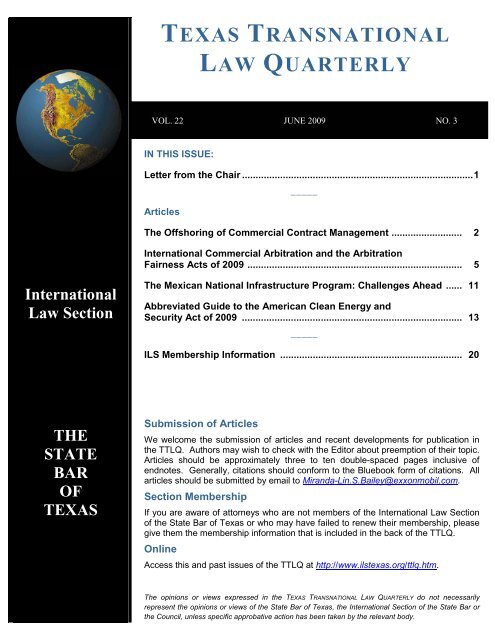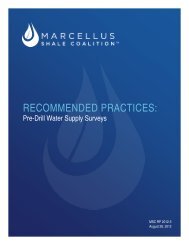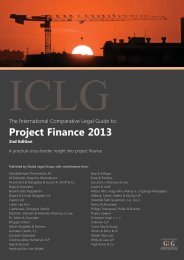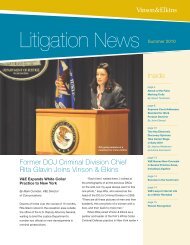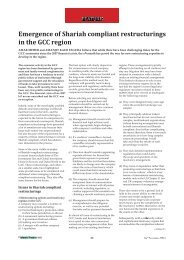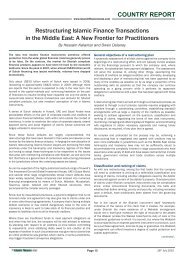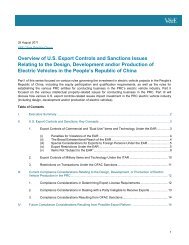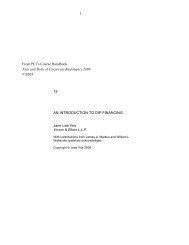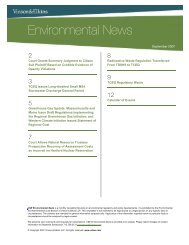TEXAS TRANSNATIONAL LAW QUARTERLY - Vinson & Elkins LLP
TEXAS TRANSNATIONAL LAW QUARTERLY - Vinson & Elkins LLP
TEXAS TRANSNATIONAL LAW QUARTERLY - Vinson & Elkins LLP
Create successful ePaper yourself
Turn your PDF publications into a flip-book with our unique Google optimized e-Paper software.
<strong>TEXAS</strong> <strong>TRANSNATIONAL</strong><strong>LAW</strong> <strong>QUARTERLY</strong>VOL. 22 JUNE 2009 NO. 3IN THIS ISSUE:Letter from the Chair .....................................................................................1_____ArticlesThe Offshoring of Commercial Contract Management .......................... 2International Commercial Arbitration and the ArbitrationFairness Acts of 2009 ............................................................................... 5InternationalLaw SectionThe Mexican National Infrastructure Program: Challenges Ahead ...... 11Abbreviated Guide to the American Clean Energy andSecurity Act of 2009 ................................................................................. 13_____ILS Membership Information ................................................................... 20THESTATEBAROF<strong>TEXAS</strong>Submission of ArticlesWe welcome the submission of articles and recent developments for publication inthe TTLQ. Authors may wish to check with the Editor about preemption of their topic.Articles should be approximately three to ten double-spaced pages inclusive ofendnotes. Generally, citations should conform to the Bluebook form of citations. Allarticles should be submitted by email to Miranda-Lin.S.Bailey@exxonmobil.com.Section MembershipIf you are aware of attorneys who are not members of the International Law Sectionof the State Bar of Texas or who may have failed to renew their membership, pleasegive them the membership information that is included in the back of the TTLQ.OnlineAccess this and past issues of the TTLQ at http://www.ilstexas.org/ttlq.htm.The opinions or views expressed in the <strong>TEXAS</strong> <strong>TRANSNATIONAL</strong> <strong>LAW</strong> <strong>QUARTERLY</strong> do not necessarilyrepresent the opinions or views of the State Bar of Texas, the International Section of the State Bar orthe Council, unless specific approbative action has been taken by the relevant body.
<strong>TEXAS</strong> <strong>TRANSNATIONAL</strong> <strong>LAW</strong> <strong>QUARTERLY</strong> – June 2009Abbreviated Guide to the American Clean Energy and Security Act of 2009ByChristopher Carr, Larry Nettles, and Gregory StapleAlso known as H.R. 2454, the 1,427-pageAmerican Clean Energy and Security Act of2009 (ACESA) was primarily authored byCongressmen Henry Waxman (D-CA) andEdward Markey (D-MA) and adopted by the U.S.House of Representatives on June 26, 2009.This abbreviated guide 1 provides an introductionto select sections of ACESA that havepotentially international implications.Overview of ACESAThis comprehensive energy and climate billcontains five titles.Title I, which focuses on clean energy,establishes a new standard for combined energyefficiency and renewable electricity that requiresmajor electric utilities to use an increasingamount of power from renewable sourcesbeginning at 6 percent in 2012 and escalating to20 percent in 2020. Up to one-quarter of thismandate can be met by energy efficiency orconservation measures, however, and statesmay also petition to have up to two-fifths of themandate met by such activities.Title I also creates the framework for a newratepayer funded program to implement carboncapture and sequestration (CCS) technologiesat fossil fuel power plants and industrial facilities;sets emission performance standards for newcoal-fired power plants; authorizes new fundingfor the large scale introduction of electric andother advanced technology vehicles; promotesthe deployment of smart electricity grids; andcreates a new “Green Bank” known as the“Clean Energy Investment Fund” within theDepartment of Energy.Title II concentrates on energy efficiency acrossmultiple sectors of the economy by advancingnew efficiency standards and programs forbuildings, appliances, industrial facilities, andtransportation vehicles. The title also createsvarious new federal grant programs to promoteenergy efficiency, including a new state blockgrant program and a state revolving loan fund tohelp manufacturers of clean energy and energyefficient products. In addition, the bill directs theDepartment of Housing and Urban Development(HUD) to integrate energy efficiency standardsinto the agency’s public housing programs;Fannie Mae and Freddie Mac are also directedto foster second mortgages to finance energyefficiency improvements.Title III, which focuses on global warming, wouldestablish an economy-wide cap-and-tradeprogram to reduce U.S. emissions of CO2 andother greenhouse gases (GHGs) by 17 percentfrom 2005 levels by 2020, and just over80 percent by 2050. Under this program, theEnvironmental Protection Agency (EPA) wouldissue a capped and steadily declining number oftradable emissions allowances to achieve thesegoals — hence the popular reference to “capand-trade.”Large GHG emitters, suppliers ofpetroleum-based fuels, and certain other partieswould be required to have a sufficient number ofallowances or GHG offset credits each year tocover their activities. Offsets are issued foractivities that reduce or sequester GHGs (e.g.,by trapping methane from landfills) by partiesnot covered by ACESA’s emissions cap.To mitigate the cost of transitioning to a lowercarboneconomy, ACESA would initiallydistribute free allowances to electric and gasutilities (for the benefit of rate payers), to energyintensive and trade-exposed industries, smallrefiners and state governments. Otherallowances would be directed to fund a variety ofGHG-reducing programs, such as energyefficiency, CCS, and renewable energy. Someallowances would also be auctioned to providefunds to reduce the impact of any energy priceincreases on low income tax payers. The newcap-and-trade program contemplated by Title IIIgenerally would preclude the EPA fromregulating GHG emissions under existingprovisions of the Clean Air Act (CAA) and wouldalso impose a temporary moratorium onanalogous state cap-and-trade programs.Title IV of ACESA contains provisions to helpenergy intensive U.S. manufacturers addressunfair competition from importers that are not- 13 -
<strong>TEXAS</strong> <strong>TRANSNATIONAL</strong> <strong>LAW</strong> <strong>QUARTERLY</strong> – June 2009subject to similar GHG regulations. This titlealso contains provisions to promote green jobs;to increase the export of clean energytechnologies; and to help communities andhabitats adapt to the physical impacts of climatechange. Climate change adaption plans arealso mandated for all federal agencies and anew foreign aid program is established toprovide climate adaption assistance to the mostvulnerable developing countries.Title V creates a new program within theDepartment of Agriculture for issuing offsetsbased on domestic agricultural and forestrypractices (e.g., altered tillage practices;reforestation activities). This program is intendedto complement the EPA’s issuance of offsetsrelated to other domestic activities as well asfrom non-U.S. offset projects.This abbreviated guide focuses on Titles III andIV of ACESA, which may be of particular interestto the international lawyer.Title III – Reducing Global Warming PollutionThis title would establish a new long termeconomy-wide program to reduce U.S.emissions of carbon dioxide and six otherGHGs 2 by issuing a steadily declining number oftradable emissions allowances. The stated goalof ACESA is to reduce total GHG emissions by17 percent from 2005 levels by 2020, and justover 80 percent by 2050.The program would be implemented by addingtwo new titles (VII and VIII) to the CAA to beprimarily administered by the EPA. Under theseamendments, each year the owners of fossilfuel-fired electric power plants, major industrialemitters, natural gas utilities, producers andimporters of petroleum-based fuels, and certainother parties are obliged to hold EPA-issuedemissions allowances or equivalent carbonrights. The allowances (and/or offset credits)must be equal in amount to the metric tons ofCO2e that were either (a) emitted in the prioryear or (b) would be released upon combustionof a covered fuel produced or imported in theprior year for sale or distribution in interstatecommerce.The new obligations would be phased in fordifferent covered entities from 2012 to 2016.Entities that emit less than 25,000 metric tons ofCO2e annually would not generally be requiredto hold GHG emissions allowances.Based on the foregoing scheme, the point ofregulation would vary by industry. Emissionsfrom coal and natural gas would be regulateddownstream at or near the point of combustion.Emissions from petroleum-based fuels andnatural gas liquids (NGLs) would be regulatedupstream where the product is first supplied tothe market. Large stationary sources of GHGemissions that are subject to the permitrequirements of the CAA (e.g., because theyemit other regulated pollutants) would also berequired to have a new or amended Title V airpermit. The permit would incorporate the newGHG compliance mandates in the bill and wouldbe predicated upon an advance compliancecommitment by the sources’ owner or operator.To reduce the compliance costs for coveredentities, the program would create a market foremissions allowances and offsets. Once issued,allowances and offsets generally could be freelytraded, and the EPA would be required toregister and track all transfers. Accordingly,entities with excess allowances would be able tosell them to entities whose annual emissionsmay exceed their own store of allowances. Thetotal number of allowances generally woulddecrease by approximately 3 percent each yearand the program contemplates that allowanceprices would rise over time — thus incentivizingreduced emissions. From 2012 to 2020,allowance prices are expected to range between$13 to $26 per ton of CO2.Distribution of Free AllowancesTo provide covered entities and consumers witha period to adjust to the compliance costsassociated with the GHG caps adopted in TitleIII, the bill distributes free allowances for aninitial period to electric and gas utilities,merchant coal generators, energy intensiveindustries, small refiners, state governments,and certain other parties. These freeallowances are typically phased out after 2025.Some allowances are also set aside to supportCCS and other clean energy technologies.Other allowances are to be auctioned to fundvarious U.S. and international climate adaptionprograms.- 14 -
<strong>TEXAS</strong> <strong>TRANSNATIONAL</strong> <strong>LAW</strong> <strong>QUARTERLY</strong> – June 2009The allocation to utilities is designed to coverapproximately 90 percent of the emissionsattributable to the fossil fuels they burn ordistribute. However, the financial benefit of theallowances must be passed through to ratepayers, and Sections 783 and 784 of the billprovide special protection for industrial ratepayers, permitting a pro rata share of suchbenefits based on energy use. During thistransition period, only approximately 15 percentof the annual pool of emissions allowances willbe auctioned by the government for the directbenefit of energy consumers. Revenues fromthese auctions will be used to provide tax creditsto low income consumers. After 2030, however,the great majority of emissions allowances areto be auctioned with the proceeds used toprovide tax refunds on a per capita basis to allU.S. households.Offset CreditsACESA contains several other provisions thatmay substantially reduce the cost of emissionsallowances for covered entities. Some of theseprovisions, however, may also dampen theincentive for covered entities to meet thenominal emissions reduction targets written intothe bill from domestic activities.Most importantly, for compliance purposes, acovered entity may substitute offset creditsderived from reducing CO2 emissions orsequestering CO2 (or other GHGs) in sectorsnot directly subject to emissions caps (e.g.,agricultural and forestry). Section 722(d)(1) ofthe bill authorizes up to two billion tons of CO2eoffset credits annually to meet the compliancerequirements of covered entities. This provisioninflates the nominal GHG emissions caps forcovered entities by up to 30 percent in the earlyyears (before 2020) and by an even largerproportion in later years (e.g., 36 percent in2030). One half of the available offset tonnagemay be satisfied by either domestically sourcedoffsets or international offsets. However, theEPA can increase the proportion of U.S.emissions that may be offset by internationalcredits by 50 percent (up to 1,500 million tons) ifenough low-priced domestic offsets areunavailable. 3Offset credits may be issued by both the EPAand the Department of Agriculture (DOA), withthe DOA responsible for offsets sourced fromdomestic agricultural and forestry activities. SeeTitle V below. The EPA is charged with drawingup an initial list of appropriate domestic offsetsand related validation procedures within oneyear and adopting final regulations for issuingoffsets within two years. Among other rewardsfor early action, the EPA must also issuedomestic offset credits to entities that reduce orsequester GHGs after 2009 under certainvoluntary “early action” programs. Eligibleprojects can only generate early action creditsfor emissions reductions through the date that isthree-years following the enactment of ACESA.These early offset credits also may beexchanged later for emissions allowances.In consultation with the State Department, theEPA would also issue U.S. offset credits derivedfrom projects in developing countries. Creditsmay be issued in exchange for pre-existingforeign credits granted pursuant to the CleanDevelopment Mechanism (CDM) or a successortreaty established by the 1992 UN FrameworkConvention on Climate Change (UNFCC). Theintegrity of CDM offsets must be assured bysafeguards that are at least as strict as those inthe bill, and all offsets generally must be verifiedby accredited third parties.In addition to using domestic and internationaloffset credits, a covered party may also satisfyits compliance obligation by using time-limited or“term offset credits” for projects that sequesterCO2 or reduce GHG emissions. However,entities using term offset credits are required topost financial security equal to the cost ofobtaining permanent credits or allowances toreplace the expired term offsets. The issuanceof term offset credits is discussed further underTitle V. 4Other Cost Containment MeasuresACESA also directs the EPA to create a“strategic” reserve of allowances equal toapproximately 2.5 billion tons of CO2e. Thisamount is roughly 2 percent of the totalallowance pool from 2012-2050. A portion ofthis reserve is to be auctioned quarterly,beginning in March 2012, at a minimum auctionprice of $28 (in 2009 dollars); the price is subjectto a 5 percent annual escalator in 2013 and2014. Thereafter, prices are set at60 percent above the rolling three-year averageof allowance prices reported by registeredcarbon trading facilities. Only covered entities- 15 -
<strong>TEXAS</strong> <strong>TRANSNATIONAL</strong> <strong>LAW</strong> <strong>QUARTERLY</strong> – June 2009are eligible to bid in these auctions and eligiblebidders may not buy allowances equal to morethan 20 percent of their most recent annualcompliance obligations. The EPA is also givenauthority to outsource strategic reserve auctionsto third parties.In addition, ACESA permits unlimited banking ofallowances for use in future compliance years.Allowances with a future “vintage” may also be“borrowed” without interest to satisfy anobligation for the immediately preceding year,thereby creating a rolling two year complianceperiod. A covered entity also may meet up to15 percent of its annual obligation by holdingallowances with vintages up to five years laterthan the compliance year, subject to an8 percent annual in-kind interest payment.Finally, ACESA permits a covered entity to holdan unlimited number of qualified internationalemissions allowances for compliance purposes.The use of foreign allowances is to beauthorized by the EPA, in consultation with theSecretary of State, if the allowances are issuedunder a GHG control program that imposes anabsolute tonnage limit and is at least as strict asACESA. This provision, along with the roleaccorded international offset credits, wouldmake the U.S. an integral part of the globalmarket for carbon rights.This market developed after the 1997 KyotoProtocol was adopted and is likely to beexpanded by any follow-on treaty to curb GHGemissions worldwide that emerges from theupcoming December 2009 meeting of theUNFCC’s signatories in Copenhagen.Supplemental Emissions ReductionsACESA sets aside a special tranche ofallowances for curbing global deforestation.Deforestation and other land use changes areresponsible for an estimated 20 percent ofannual global GHG emissions, and the sponsorsof the bill believe that mitigation of these trendsoutside the United States may be more costeffective ton-for-ton than many U.S. GHGreduction measures. The set-aside is equal to5 percent of the total U.S. allowance pool from2012-2025 and 2-to-3 percent of the poolthereafter. These allowances may be distributedby the EPA as funding in-kind to eligibledeveloping countries, international organiza-tions, and private or public groups to stemdeforestation. The goal is to achieve cumulativesupplemental GHG reductions of 720 milliontons of CO2e by 2020 and six billion tons by2025.The bill also grants the EPA broad authorityunder the CAA for drawing up emissionsstandards for uncapped stationary sources ofGHG that exceed 10,000 tons of CO2e annually(e.g., are below the proposed 25,000 tons/yearthreshold) and, in the aggregate, are responsiblefor at least 20 percent of the uncapped GHGemissions. Under new Section 811 of the CAA,the EPA would be required to bring theseuncapped sources under the agency’s newstandards over a 10-year period. Compliancecosts under a new standard are not to exceedthe costs that would be incurred if a regulatedentity had to obtain emissions allowances.Greenhouse Gas ReportingTo evaluate the program’s effectiveness and toprovide a factual basis for auditing compliance,Part B of Title VII establishes a new federalGHG registry. It is to be based on new quarterlyGHG emissions reports from all covered entitiesbeginning in March 2011.The EPA is also directed to obtain quarterlyreports from other entities that would be coveredby ACESA had they met the annual 25,000metric tons of CO2e threshold, so long as theyemit at least 10,000 metric tons of CO2e in anyyear. Emissions data is to be self-certified andfiled electronically. The EPA must publish allGHG emissions data on the internet subject tothe protection of certain confidential businessinformation.The GHG registry provisions in the bill aresimilar but not identical to the EPA’s proposedGHG registry rules released for public commentin March 2009. Thus, if the EPA’s GHGreporting rules are adopted prior to the passageof ACESA, it is possible that the Congress willdefer to the agency’s rules and delete any GHGregistry provisions from the cap-and tradeprovisions. On the other hand, to the extent thatany new law would cover a broader range ofparties than the agency’s reporting rules nowcontemplate (e.g., because uncapped sourcesemitting more than 10,000 tons of CO2eannually may be subject to future emissions- 16 -
<strong>TEXAS</strong> <strong>TRANSNATIONAL</strong> <strong>LAW</strong> <strong>QUARTERLY</strong> – June 2009standards), then the current GHG registry rulesmay remain.State Pre-emptionThe new cap-and-trade program mandated byACESA would not completely pre-empt stateGHG regulations. Instead, new Title VIII, Part Fto the CAA would place a six-year moratorium(2012-2017) on the implementation orenforcement of analogous GHG emission caps.The moratorium only applies to state GHGcontrols that are based on an absolute tonnagelimit and preserves the right of the states tomaintain alternative GHG control measures(e.g., emission performance standards) or toadopt programs addressing entities that are notcapped at the federal level. There is also noattempt to pre-empt state GHG reporting rules.To assist entities facing significant compliancecosts under three existing state GHG caps —the Regional Greenhouse Gas Initiative (RGGI),the Western Climate Initiative, andCalifornia Assembly Bill 32 — Part H of Title III(at Section 790) directs the EPA to adoptallowance exchange rules. Under the rules,state GHG allowances issued prior to January 1,2012, when the federal program generallybecomes effective, can be exchanged for federalemissions allowances in an amount sufficient tocompensate a party for the cost of obtaining andholding the state allowances. Federalallowances so exchanged are to be subtractedfrom the allowance pool that would otherwise beauctioned.Oversight of Carbon MarketsThe cap-and-trade scheme established byACESA would be likely to create a market forU.S. emissions allowances and offset creditstotaling over $50 billion a year in 2012.Accordingly, ACESA provides for oversight ofthe market for carbon rights and derivativeinstruments by the FERC and the CommoditiesFuture Exchange Commission (CFTC). TheFERC is given jurisdiction over trading ingovernment-issued allowances and offsets. 5The CFTC would regulate derivatives, (futurescontracts, swaps) unless an interagency workinggroup to be convened by the Presidentrecommends otherwise; in that event additionallegislation might be required.Regulators must adopt strict measures toprohibit fraud, market manipulation, and excessspeculation. Rules to foster market transparencyand to limit or eliminate counterpartyrisk, market power concentration risks, and otherrisks associated with over-the-counter tradingare also mandated.The FERC and any other federal agency withjurisdiction over the trading of any regulatedemissions right or contract is granted the sameenforcement powers as the CFTC. Marketmanipulation, fraud, and false or misleadingstatements regarding a regulated instrument is afelony punishable by up to 20 years in prisonand a fine of up to $25 million.Pending the adoption of comprehensive legislationto reform the regulation of derivatives,ACESA also expands the power of the CFTC toregulate derivative transactions related toenergy commodities, including coal, crude oil,gasoline, diesel and jet fuel, propane, electricityand natural gas. The CFTC is granted authorityto set position limits regarding such contracts, torequire detailed reporting of market data and tomandate clearance of contracts throughregistered derivatives clearing organizations.Exemptions may be granted for bona fidehedging operations.The broad and unprecedented sweep of thesenew CFTC market oversight provisions are ofwidespread concern in the energy industry.Among other things, this concern led to a lastminute amendment that provides for the repealof the CFTC’s expanded authority over energyderivatives upon adoption of general “legislationthat includes derivative regulatory reform.” 6Regulatory EnforcementACESA includes various provisions to ensurethat covered entities meet their annualcompliance obligations. If a covered entity failsto hold the required number of emissionsallowances, it shall be liable to a penalty equalto twice the fair market value of the missingallowances. The violator also must make up thedeficit in the next year or such longer period asthe EPA may provide.Violation of the new CAA titles added byACESA, or the EPA rules adopted thereunder,may subject a covered entity to civil andadministrative penalties under the CAA.- 17 -
<strong>TEXAS</strong> <strong>TRANSNATIONAL</strong> <strong>LAW</strong> <strong>QUARTERLY</strong> – June 2009Criminal penalties may also be sought by theEPA for knowing violations of the CAA or theEPA’s rules. Significantly, however, the billpassed by the House drops provisions in earlierversions that created liberal standing provisionsfor citizens to bring suit to enforce ACESA.Title IV – Transitioning to a Clean EnergyEconomyPreserving Domestic CompetitivenessSubtitle A begins by establishing an annualrebate program for certain industrial sectorsbased around the concept of “carbon leakage.”This term is defined as any substantial increasein GHG by manufacturing entities located incountries without commensurate GHG regulationsthat is “caused by an incremental cost ofproduction increase in the United States” due toU.S. GHG regulations.Certain energy-intensive, greenhouse-gasintensive,and trade-intensive sectors andsubsectors (defined through the six-digitclassification in the North American IndustrialClassification System (NAICS)) will bepresumptively eligible for the rebate program. Inaddition, any person may petition the EPA todesignate a sector as rebate-eligible. Theamount of rebate available is calculated by anentity according to a defined formula taking intoaccount the entity’s cost of compliance withGHG regulations, manufacturing output, GHGemissions-intensity, and electricity efficiency.Eligible industrial sectors would be determinedno later than June 30, 2011, along with the initialvalue of rebates per unit of production for eachsector.By February 1, 2013, the EPA must publish thefirst updated list of eligible sectors and rebatevalues, with future updates required every fouryears. Rebates in the form of emissionallowances will be distributed for each vintageyear no later than October 31 of the precedingcalendar year. Beginning in 2026, the rebateamount is to be reduced by 10 percent annuallyuntil the rebate program is phased out.Additionally, the rebates applicable to aparticular sector may be subject to anaccelerated ten year phase out period based ona Presidential determination that more than85 percent of the global output from a sector ismanufactured in countries that are parties to aninternational climate change agreement, orotherwise have a GHG intensity comparativelyless than that of the comparable U.S. sector.International Reserve AllowancesSubtitle A also states that, absent U.S.participation in a multilateral climate changeagreement meeting certain specified objectivesby January 1, 2018, or a finding that aninternational reserve allowance program wouldnot be in the national economic interest as to aparticular sector, the President shall establish aninternational reserve allowance program foreach eligible industrial sector. Should thePresident make such a finding that aninternational reserve allowance program isunnecessary as to a particular sector for thereasons set forth above, a joint resolution ofCongress is necessary to approve such adetermination to avoid imposing the program.If an international reserve allowance program isestablished, the EPA, in conjunction with U.S.Customs and Border Protection, must adoptrules requiring U.S. importers in identifiedsectors to purchase international reserveallowances. The program could take effect asearly as January 1, 2020. The EPA would alsoset the price of the allowances equal to theauction clearing price established at the mostrecent emission allowance auction, and set fortha methodology for determining the quantity ofinternational reserve allowances to be tenderedin conjunction with the importation of a coveredgood. However, covered goods produced ineither “foreign countries that the United Nationshas identified as among the least developed ofdeveloping countries” or foreign countriesresponsible for less than 0.5 percent of the totalglobal GHG emissions would be exempt fromthe program.Exporting Clean TechnologyUnder Subtitle D, the President is to establish an“interagency group” which will determine theeligibility of developing countries to receiveassistance to encourage widespread deploymentof technologies that reduce GHGemissions and to encourage the adoption ofpolicies that substantially reduce emissions ofGHGs. In addition, the assistance willencourage compliance with existing international- 18 -
<strong>TEXAS</strong> <strong>TRANSNATIONAL</strong> <strong>LAW</strong> <strong>QUARTERLY</strong> – June 2009property rights. Only developing countries thathave ratified an international treaty, have put inforce national policies, and have undertaken“nationally appropriate” GHG mitigation activitiesthat will achieve substantial GHG reductions areeligible for funding. The Secretary of State, inconsultation with the interagency group, isauthorized to select eligible projects to receivefunding.Assistance will be allowances allocated for cleantechnology activities in the form of bilateralassistance to multilateral funds or institutions.Such activities include those that achievesubstantial reductions in GHG emissions and/orachieve capacity building. Sample projectsinclude: CCS; renewable electricity generation;projects that increase the efficiency of electricityconsumption, distribution, or transmission; andprojects that reduce transportation sectoremissions through increased efficiency or use offuels that have lifecycle emissions that aresubstantially lower than those attributable tofossil fuel-based alternatives.Adapting to Climate ChangeSubtitle E establishes an interagency committeeconsisting of representatives from variousfederal agencies conducting global changeresearch to ensure an integrated federalresponse to the impacts of climate change. Theinteragency committee is directed to undertakevulnerability assessments, coordinate federaland international activities with global changeresearch activities, and serve as the forum forthe development of the “National Global ChangeResearch and Assessment Plan.” ThePresident will develop the Plan, which willcontain global change research andassessment. The President will also establishan interagency United States Global ChangeResearch Program, lead by the Office ofScience and Technology Policy.The Under Secretary of Commerce for Oceansand Atmosphere, building upon the resources ofthe National Weather Service and the weatherand climate programs of the National Oceanicand Atmospheric Administration (NOAA), isdirected to establish a National ClimateService (NCS). The NCS will coordinate NOAAprograms and serve as a clearinghouse toprovide federal, state, local, and tribalgovernment decision-makers with access toinformation relating to the impacts of climatechange and adaption to such impacts. Eachfederal agency 7 is directed to review climateimpacts on matters within its jurisdiction anddevelop plans for addressing those impacts.The bill also establishes a climate changeadaptation fund to provide federal support forstate, local, and tribal projects to reducevulnerability to climate change impacts. Inaddition, the bill requires the Secretary of Healthand Human Services to promulgate a nationalstrategy for mitigating the impacts of climatechange on public health. The bill furtherestablishes an interagency Natural ResourcesClimate Change Adaption Panel to address theimpacts of climate change on natural resources.A special fund will be created to carry outadaptation activities related to natural resources.Finally, to address international adaptationissues, the bill creates an International ClimateChange Adaptation Program within USAID toprovide U.S. assistance to help the mostvulnerable developing countries adapt to climatechange.Authors: Christopher Carr, Larry Nettles, andGregory Staple are attorneys at the Houstonoffice of <strong>Vinson</strong> & <strong>Elkins</strong> <strong>LLP</strong>. They can becontacted via e-mail through www.velaw.com.1 This article contains excerpts from <strong>Vinson</strong> & <strong>Elkins</strong> <strong>LLP</strong>’slarger publication on the topic, which is available through theauthors or by contacting Wayne Harris, atwharris@velaw.com.2 The other GHGs are methane (CH4), nitrous oxide (NOX),sulfur hexafluoride (SF6), and hydrofluorocarbon, aperfluorocarbon and nitrogen trifluoide. The EPA is alsogiven discretion to bring other anthropogenic gases underthe new program.3 After 2017, however, a covered entity must hold 1.25international offsets in lieu of every one emission allowance.4 Significantly, however, if an entity substitutes a regulardomestic offset credit for a term offset credit, the use of thatdomestic credit is not subject to the 50 percent limit on useof such credits. See Section 722(d)(2)(D).5 Under Title I, FERC also will police the market for the newfederal renewable energy certificates (RECs) issued by theagency.6 See Part IV, Subtitle E of Title III at Section 358.7 Including NOAA, EPA, the Departments of Agriculture,Commerce, Defense, Energy, Health and Human Services,Homeland Security, Housing and Urban Development,Interior, and Transportation, as well as the Army Corps ofEngineers, the Centers for Disease Control, FEMA, NASA,and the United States Geological Survey.- 19 -


